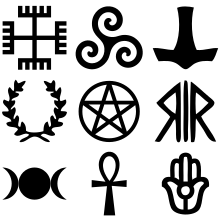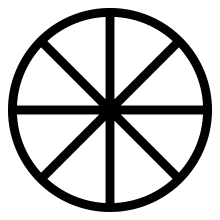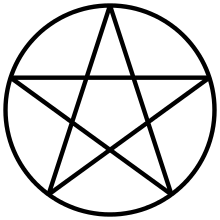Neopaganism in Australia
Contemporary Paganism, including Wicca in various forms, Reclaiming (Neopaganism), and witchcraft, is a growing minority religious group in Australia. As in forms on Neopaganism elsewhere, some pagans work as solitary practitioners and others form groups such as covens. Covens may or not be hierarchical, depending on the tradition. Gardnerian and Alexandrian covens tend to be hierarchical, with coven led by a Priest and High Priestess. Reclaiming covens and working groups practise non-hierarchical modes of group dynamics, with group members co-creating rituals and events, although there may be 'facilitators' and other roles allotted at a given gathering.


Ceremonial magicians of various traditions are also a growing group within Australian alternative religion, however they generally do not identify as 'pagan'. Nevertheless, there is considerable crossover between the interests of, and membership in, pagan and magical groups.
History
Alexandrian Wiccans and Gardnerian Wiccans arrived in Australia from England and the United States around the late 1960s.[1]
Demographics
In June 2003, Nature Religions, including Druidism, Paganism, Pantheism and Wicca, were described by Phillip Hughes and Sharon Bond as “the fastest growing group of religions in Australia” between 1991 and 2001.[2] In 2018, Paganism and Wicca were also described as among the "least urbanised religions in Australia".[3]
In the 1991 census by the Australian Bureau of Statistics, 4,353 Australians identified their religion as a Pagan religion including, 1,367 Australians identified their religion as Wicca or Witchcraft.[4]
In the 1996 census, 10,052 Australians identified their religion as a Pagan religion including 1,849 people who identified their religion as Wicca or Witchcraft.[4]
In the 2001 census, 24,156 people described themselves as Pagan, including 8,755 people who identified their religion as Wicca or Witchcraft.[4]
The PAGANdash campaign was started to help government and community get a correct representation of the number of Pagans currently in Australia. Originating from the Pagan Community Projects in Queensland in 2005, the Pagan Awareness Network (PAN) also ran a comprehensive PAGANdash program prior to the 2011 census in Australia. All Pagans were asked to fill in their religion as Pagan-(religion), for example a Wiccan would write Pagan-Wiccan as their religion.[5]
In the 2006 census, 29,391 Australians identified their religion as a Pagan religion including 8,207 people who identified their religion as Wicca or Witchcraft.[6]
In the 2011 census, 32,083 Australians identified their religion as a Pagan religion including 8,413 people who identified their religion as Wicca or Witchcraft.[6]
In the 2016 census, 27,194 Australians identified their religion as a Pagan religion including 6,616 people who identified their religion as Wicca or Witchcraft. The largest affiliation of nature religions were 'Pagan' (15,219; 66% female). 'Wiccan' (6,616; 79% female) and 'Nature Religions not elsewhere classified' (3,075; 65% male); the largest affiliation by age, were 'Nature Religions not elsewhere classified' (25–29 years), 'Nature Religions, not further defined' (40–44 years), 'Pagan' (40–44 years), 'Wiccan' (45–49 years), 'Animism' (50–54 years) and 'Druidism' (50–59 years).[7]
See also
References
- Douglas Ezzy (2009). "Australian Paganisms". In Pizza, Murphy; Lewis, James R (eds.). Handbook of Contemporary Paganism. Leiden: BRILL. p. 465. ISBN 9789004163737.
- Phillip Hughes and Sharon Bond, "Nature Religions" Pointers, 13.2 (June 2003): 1
- "Census reveals we're on a slow path to becoming a more multicultural society". Central Western Daily. Retrieved 24 May 2019.
- Phillip Hughes and Sharon Bond, "Nature Religions" Pointers, 13.2 (June 2003): 5
- "HISTORY What is the PAGANdash campaign?". pagandash.org.au. Retrieved 18 November 2012.
- "PAGANDASH - STAND UP AND BE COUNTED Results of the 2011 Census". pagandash.org.au. 2012. Archived from the original on 15 March 2013. Retrieved 18 November 2012.
- "Stories from the Census, 2016, Data Cubes, Religion". ABS. 11 July 2018. Retrieved 24 May 2019.
Further reading
- Hume, Lynne (1997). Witchcraft and Paganism in Australia. Melbourne: Melbourne University Press. ISBN 9780522847826.
- Caroline Tully. ‘The Sabbats.’ In Practising the Witch's Craft. Ed. Douglas Ezzy. 169–188. Crows Nest NSW: Allen and Unwin, 2003.
- Bodsworth, Roxanne T (2003). Sunwyse: Celebrating the Sacred Wheel of the Year in Australia. Victoria, Australia: Hihorse Publishing. ISBN 9780909223038.
